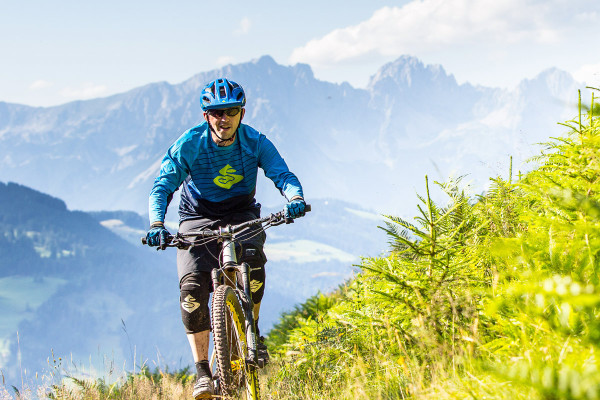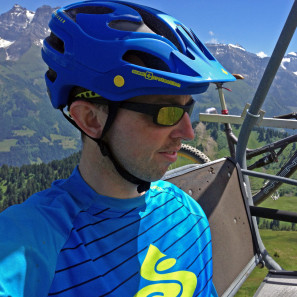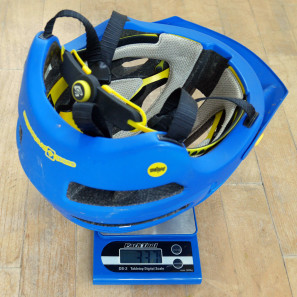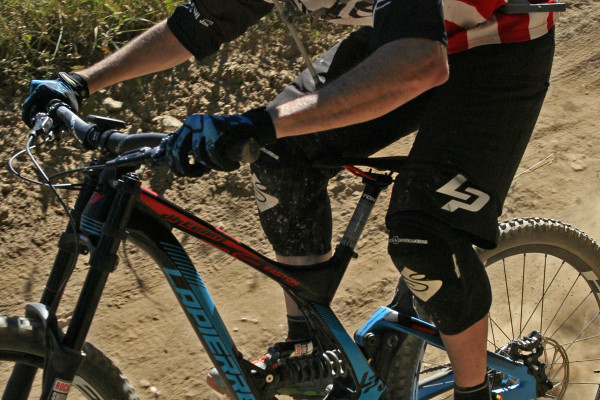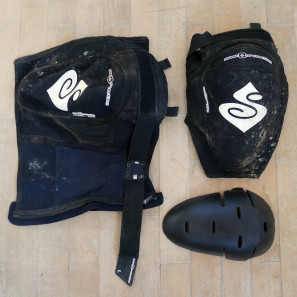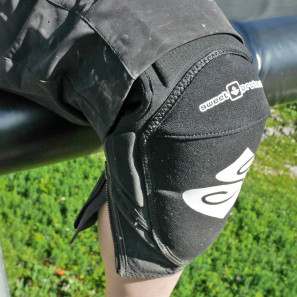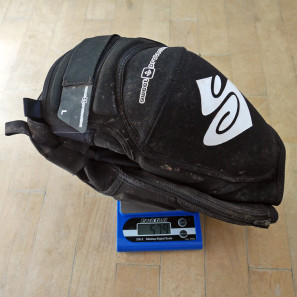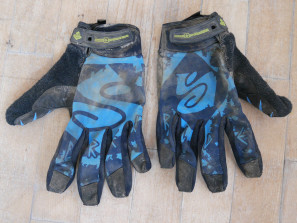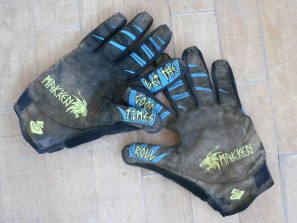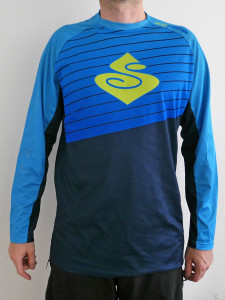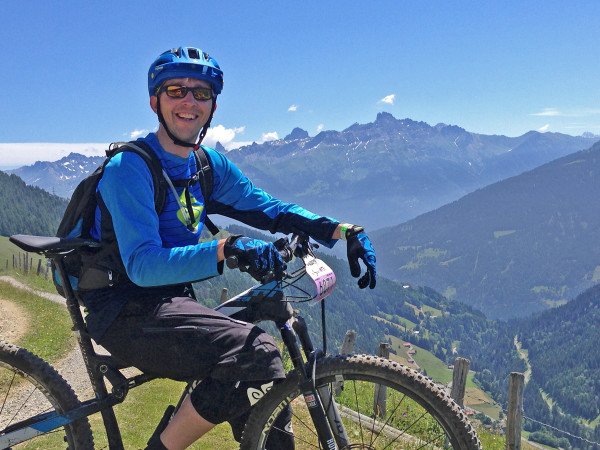With a couple months of hot and dry weather across Europe, we’ve spent the better part of this summer getting as much trail riding in as we could. It was something of an idea to stay in the forests out of the sun a bit, but also a chance to get back to my personal technical mountain biking roots. With a few extended lift-assisted trips in some proper mountains, it also has been a chance to do some product testing on some more Enduro-leaning products. One kit we reached to a lot has been a 2016 preview that found its way to us from Norway by Sweet Protection. With a basic protection setup including a MIPS helmet, knee pads, and a pair of new lightweight gloves, I’ve done my best to put them to the test without going so far as to smacking my head on the ground or into any trees (at least not very hard, although it came close a few times.) Matched up with a lightweight long sleeve jersey and an over-the-knee pair of shorts the Sweet Protection gear has been a solid pick whenever the trail gets rough and the descents long.
Hop past the break for the low-down on each piece and our thoughts after a couple of months of riding up, over, and down a few mountains…
Bushwacker MIPS
Starting off with the Bushwacker MIPS Helmet in a new for 2016 Bird Blue for more visibility, Sweet Protection puts together a light and airy feeling lid that does well to offer extended occipital coverage down the back of the head. From a technical standpoint, we are happy to see MIPS tech making it into more helmets giving us some extra security, and this seems like a perfect place for it. The Bushwacker uses standard in-mold construction, but takes some nice attention to detail by molding the multi-piece outer polycarbonate shell in such a way that all of the EPS foam edges are protected from the outside, meaning the helmet will likely be pretty durable even being tossed in your gear bag. Sweet’s Occigrip retention system provides easy-to-use and comfortable adjustment at the turn of a dial, that was both light and snug with adjustment for height and sliding back up into the helmet for transit. At just 337g for our M/L sized sample it even came in lighter than advertised.
The helmet’s pads have a super soft almost cozy feel to them that really made the fit comfortable. We were a bit concerned at first that this was going to make it a hot helmet, especially combined with the MIPS layer which is notorious for decreasing ventilation. The Bushwacker proved that preconception wrong, as it turns out to be the coolest running all-mountain helmet I’ve used in recent memory. A few well placed/designed internal channels seem to move air through the helmet well enough, and the layout of those soft pads did an admirable job of keeping sweat from dripping into my eyes (something I can’t say about even most airy XC or road helmets.) The pads have also held up well to a couple of sweaty months and still are soft as new. Ultimately low speed climbing eventually did overcome the vents, but its hot weather performance did surprise anyway.
I wiped out a couple of time in the Sweet Protection kit, but luckily never ended up on my head. I did however have a few close encounters with low-hanging branches and the removable ABS visor took a nice hit with only a small cosmetic scratch to remember it by. At €200 the Bushwacker MIPS is definitely a premium helmet, but from our tests it is hard to beat. A non-MIPS version is available for a bit less, and a carbon fiber reinforced one for a bit more. The carbon one doesn’t shed weight but reinforces some of the shell for a supposed 15% protection boost, whether that is better impact absorption/distribution or better durability we aren’t exactly sure, but have been very happy with the version we’ve had on test.
Bearsuit Pro Knee Pads
The next piece out of the group has gotten a bit more in the ways of actually testing the protection capabilities or an attempt at destructive testing. We’ve drug the Bearsuit Pro Kneepads through some nasty loose gravel (that our unprotected forearm skin didn’t do as well on) and put a knee or two down on some rooted forest DH trails. The knee pads haven’t seemed to mind at all. With a few crashes in them the pad inserts look as good as new, the outer fabric is not abraded at all, and outside of some small scuffing of the big S logo all they have needed was a good rinse.
The asymmetric €130 Pro pads are definitely of the heavy-duty variety and are made primarily of a perforated neoprene base, combined with a reinforced fabric in the impact zones and a more breathable lycra where possible. It’s no doubt that this type of pad is going to be pretty hot and sweaty, but once they were in place we mostly forgot about them and they weren’t uncomfortable even on the hottest days of the summer. The sticky nature of the neoprene, combined with a large elastic strap at the top kept them in place, and their anatomic cut and pad layout moved smoothly pedaling. We rode with them one day for 7 hours and 115km in 35°C heat (the Pass’Portes du Soleil), only taking them off to eat lunch, and never felt them slide down or had any chafing issues.
Their protection amounts to a large removable SAS-TEC Prestige viscoelastic foam pad over the knee and smaller molded-in EVA foam pads on the side of the knee and above it for extra protection. The main SAS-Tec pad is soft and flexible, and perforated for better ventilation, but absorbs and distributes sudden impacts then rebounds back to its original shape to continue to offer protection.
The pads have a full length zipper that sits on the inside of the leg making them fairly easy to get on and off. This would be where the only real issues we had came from. The best way to put the pads on seems to be to zip them up around your calf and then to slide them into position, as it was almost impossible to zip them in place. But behind the entire zipper is a strip of neoprene to prevent chafing, and when we didn’t pay attention to it when we slid the pads up, it would bunch up at the top, irritating our leg when pedaling and sweating. A quick tug on this strip of neoprene once the pads were in place easily alleviated the problem, though. The only other issue was with the zipper too and has been updated in the new 2016 versions (ours were from current 2015 stock). Since the zip faces down and flips back up to lock on the inside of the leg, occasionally when riding it unlocked itself letting the pads partially unzip. It never happened more than about 1/3 of the way (just above the calf), so the pads stayed put, but Sweet says that next year zipper will be reversed, so the problem should be solved.
The fit on our size Large pads was still snug at the upper leg even before tightening the 2nd strap, which then comfortably held the pads in place. At 48cm my thigh circumference put me on the edge between sizes M and L, but we would definitely recommend sizing up if you are close as a smaller size would have likely been uncomfortable. At 579g for the pair they aren’t exceptionally light (although Sweet does make a lighter version that omits the zipper and secondary pads), but we appreciated the protection and the ease of zipping them on and off.
Makken
New for 2016 are a light pair of Makken gloves. We didn’t get much detail on them before we hit the trail, but they offer a thin breathable lycra back, an unpadded synthetic palm, a velcro closure, and terry cloth nose wipes. We gave them some crash testing along with the pads, and they stood up to the fast DH wash-out sliding down the gravel that gave me a couple of stitches. And that’s their after pics above. Good as new once they got a bath.
The light gloves’ fit is a bit loose off the bike, but didn’t bunch up while riding. It probably comes down to a cut that seems mostly straight, not curved to a riding position, but the stretchy lycra back and in between the fingers takes up that slack when we wrapped our hands around the bar. The thin back of the glove doesn’t offer any protection, and one close encounter with a tree left an abrasion on one glove (and the hand underneath.) But overall they have been a great summer weight glove and have stayed on top of our pile for two months straight. The gloves have a lot to say between knuckle tats and silicone printing on the palms and fingers that add a little extra grip. They have similar construction to the current La Grange gloves and expect them to be in the same €35-40 range when they become available in time for 2016 riding.
Chumstick and Hunter Enduro
Our 2016 Malibu Blue Chumstick jersey is a graphic update to the current version of the loose fitting, long sleeve top. It is made of a fast wicking, fast drying technical polyester with a silver chloride treatment to keep it odor free, and gets a Bluesign sustainable stamp of approval. Even with long sleeves the jersey feels light on the skin (this one weighed just 188g), and air moves through it well enough to overcome the seemingly plastic-y first feel. It did keep me cool and out of the sun, which was welcome mostly on that 7hr ride that spent a lot of time above the tree line in the heat. The fabric never felt wet, breathing well while I sweated all day, as the loose fit let it flap in the breeze to stay dry. The only real down side to the cut, at 185cm/6’1″ the sleeves were a little too short on the bike. You can see in the photo above, that standing they are fine, but with the raglan sleeves and a hydration pack, on the bike there was regularly 10+cm of wrist showing above my gloves. Even without a back pack in the photo at the top and standing still below the arms ride up a bit. We don’t usually spend a lot of time in long sleeve jerseys until the weather gets cold, but this €80 top has been a pretty reasonable option. It gets pulled out now mostly to hide our skin from long days in the sun or for those rougher Enduro rides where elbow pads aren’t really necessary, but it’d be nice to have something between our skin and the ground if it came to that.
Last up are Sweet’s Hunter Enduro shorts. These are a long, heavy weight short designed for aggressive trail riding where you want protection from the weather and the trail. They reach well below the knee off the bike and seemed like they might catch on the knee pads. But of course Sweet thought of that and on the bike they mesh perfectly with the Bearsuit knee pads, falling nicely just above the kneecap and keeping mud and dirt from coming between the two. The DWR treated, 2-way stretch shorts shed mud and wet spray instantly to keep you dry and clean. But when the trails are dry the matte finish of the fabric seems to be a magnet for dust, and the black shorts collect a nice brown layer pretty quickly that has to be brushed off. The €120 shorts have laser cut perforations to vent along the inseams plus two long mesh-backed zip vents on the legs. They get slash mesh cargo pockets too, which can serve as extra vents if you aren’t carrying anything there. Two more regular zippered slash pockets give them plenty of hauling capacity. The shorts are held up by an elastic belt with a velcro-adjustable waist band that lets you fine tune fit since they don’t use any waist band grippers. Even so, the shorts stayed up quite well, not sliding down much whether they were ridden over shorts or bib liners, or by themselves. As they are a bit longer, we tended to ride them when the trails were more likely to be wet or when the temperatures weren’t too hot.
Final Thoughts
All in all the full kit from Sweet has excelled on the kind of riding you would expect from a company with Protection in their name. The helmet kept our head safe, with the added security of MIPS, and did so in a surprisingly well vented and comfortable package. Thanks to the great fit, it has since become our go to for all off-road riding. The knee pads took a lot of abuse in a relatively short period of time, and we didn’t feel a thing, while they essentially still look as good as new. They’ll likely get a lot of riding time whenever gravity is involved and will always get pulled out for any lift-served riding. The gloves also stood up well to crashing, and with the lightweight lycra backs we’ll just try to remember to not punch any more trees any time soon. They likely won’t get much road riding, but might even make it out on the cross bike. We really love a good light pair of full-finger gloves that can withstand sliding across rough gravel, and I get the feeling that these will be ridden until they come apart at the seams. Here’s to hoping that is a long way off.
I’m never quite as sure about long sleeved jerseys and really long shorts. Even coming from a technical trail riding background, I feel most comfortable in closer fitting shorts and jerseys, and rarely break out long sleeves before it gets really cold. That being said, these two are growing on me. The water-repellant shorts really excelled when the trails had extended wet sections, and I was pleasantly surprised that the jersey was almost always dry when I took it off after riding. These two will probably get a bunch more riding time in the autumn when the trails gets damp again and when we try to get in those last freeride runs before the lifts go back to hauling skiers up the hills.
